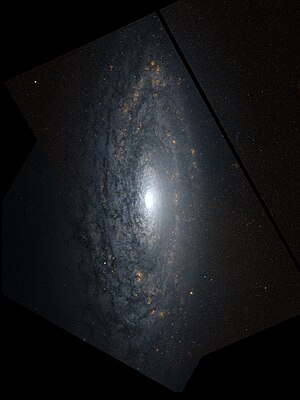NGC 3675
| Galaxy data from NGC 3675 |
|
|---|---|

|
|
| Photo from the Hubble Space Telescope | |
| AladinLite | |
| Constellation | Big Bear |
|
Position equinox : J2000.0 , epoch : J2000.0 |
|
| Right ascension | 11 h 26 m 08.6 s |
| declination | + 43 ° 35 ′ 09 ″ |
| Appearance | |
| Morphological type | SA (s) b / HII / LINER |
| Brightness (visual) | 10.0 mag |
| Brightness (B-band) | 10.8 mag |
| Angular expansion | 5.9 ′ × 3.1 ′ |
| Position angle | 178 ° |
| Surface brightness | 13.0 mag / arcmin² |
| Physical data | |
| Redshift | 0.002568 +/- 0.000005 |
| Radial velocity | 770 ± 1 km / s |
|
Stroke distance v rad / H 0 |
(36 ± 3) x 10 6 ly (10.9 ± 0.8) Mpc |
| history | |
| discovery | William Herschel |
| Discovery date | January 14, 1788 |
| Catalog names | |
| NGC 3675 • UGC 6439 • PGC 35164 • CGCG 214-005 • MCG + 07-24-004 • IRAS 11234 + 4351 • 2MASX J11260858 + 4335093 • GC 2413 • H I 194 • h 887 • NVSS J112608 + 433512 • LDCE 867 NED018 | |
NGC 3675 is an active spiral galaxy with extensive star formation regions of the Hubble type Sb in the constellation Great Bear in the northern sky . It is estimated to be 36 million light years from the Milky Way and about 60,000 light years in diameter.
The supernova SN 1984R was observed here.
The object was discovered by Wilhelm Herschel on January 14, 1788 .
Web links
Commons : NGC 3675 - collection of images, videos, and audio files
